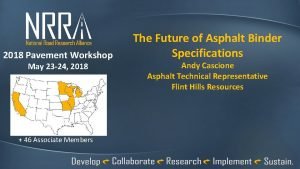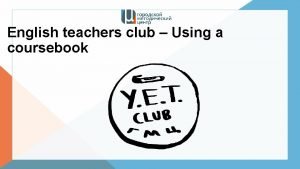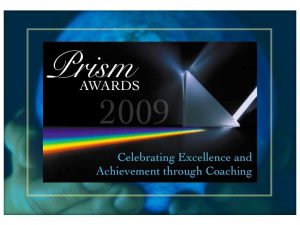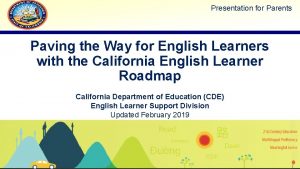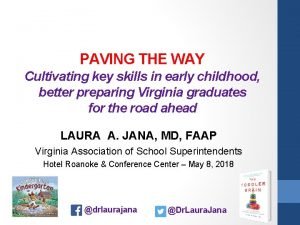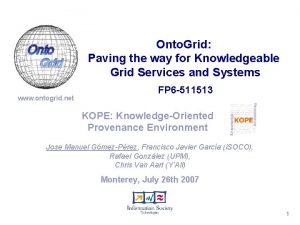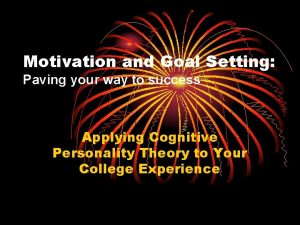Presentation for Teachers Paving the Way for English





























- Slides: 29

Presentation for Teachers Paving the Way for English Learners with the California English Learner Roadmap California Department of Education (CDE) English Learner Support Division Updated February 2019

Outcomes • To understand the context of the English Learner (EL) Roadmap Policy • To become familiar with the policy and its principles • To understand the development process, organization, and purpose of the Guidance Document and Web-based Resources • To reflect on your role in the implementation process and assess your classroom, grade level, and school’s progress and next steps • To use the self-assessment rubric to identify areas of strength and areas for growth and generate an action plan based on the self-assessment 2

Welcome! Please take a moment to share with your table group: – Your name and where and what you teach – Why is learning about the EL Roadmap important to your work? 3

Why a Roadmap? • To provide guidance to schools, districts, and counties on research-based approaches to support and embrace English learners • To ensure that all English learners have access to a twenty-first century education and feel welcome and supported at school • To ensure that the parents of English learners are welcomed and embraced as assets to the school and district 4

How Was the Roadmap Created? • The EL Roadmap Workgroup – Met over two years to provide input and to assist in the development of the EL Roadmap Policy and associated guidance – Included teachers, parents, administrators, superintendents, County Offices of Education, districts, and advocacy organizations 5

The CA EL Roadmap and the California Way Field Input Legal Foundations 6

New English Language Development Historical Perspective (ELD) Standards Adopted CA State Seal of Biliteracy established Era of English-only research, 2012 CA EL policy, and accountability Roadmap Lau v. Nichols 1990 s National Literacy Panel on Every Policy 1974 Castañeda v. Language Minority Student approved Pickard Children and Youth Succeeds 2017 1981 2006 Act 2015 1976 CA Bilingual. Bicultural Act Era of building programs, practices, and approaches 2010 CA Common Core 2001 State Standards (CCSS) 1998 No Child Left Proposition Behind 2014 227 The CA English Language Arts/ ELD Framework is adopted 2016 CA Education for a Global Economy Initiative (Proposition 58) 7 passed

California State Board of Education July 12, 2017 Video available at https: //www. youtube. com/watch? v=wq 6 PYsu. RG 8 o&feature=youtu. be 8

The CA EL Roadmap Defined The California English Learner Roadmap: Strengthening Comprehensive Educational Policies, Programs, and Practices for English Learners (CA EL Roadmap) – State Board Policy – Guidance Document – Web-based Resources 9

The Policy vs. Guidance CA EL Roadmap Policy CA EL Roadmap Guidance Document • CA EL Roadmap Policy is the • The CA EL Roadmap State Board of Education’s guidance document direction for the state. provides guidance on how – This means that schools and to implement the policy districts use the policy to implement their programs. – This means that schools and districts may use this document to assist with implementation, but may make local decisions on how best to implement the policy. 10

Vision English learners fully and meaningfully access and participate in a twenty-first century education from early childhood through grade twelve that results in their attaining high levels of English proficiency, mastery of grade level standards, and opportunities to develop proficiency in multiple languages. 11

Mission California schools affirm, welcome, and respond to a diverse range of English learner strengths, needs, and identities. California schools prepare graduates with the linguistic, academic, and social skills and competencies they require for college, career and civic participation in a global, diverse, and multilingual world, thus ensuring a thriving future for California. 12

Four Interrelated Principles • Principle One: Assets-Oriented and Needs-Responsive Schools • Principle Two: Intellectual Quality of Instruction and Meaningful Access • Principle Three: System Conditions that Support Effectiveness • Principle Four: Alignment and Articulation Within and Across Systems 13

Principles to Elements PRINCIPLE Element s p Element e l ab e t S n o Element A i t c 14

The Four Principles Video available at https: //youtu. be/YXfm. PRs. EYMs? list=PLz. AV 3 ARc. Mmw 1 lh. X 2 vpb 6 RSb. DSYt 8 mv. PE 15

Principle One: Assets-Oriented and Needs. Responsive Schools Pre-schools and schools are responsive to different English learner strengths, needs, and identities and support the socioemotional health and development of English learners. Programs value and build upon the cultural and linguistic assets students bring to their education in safe and affirming school climates. Educators value and build strong family, community, and school partnerships. • Please look over the elements under principle one and briefly discuss: • What would this principle look like in action at the classroom, school, and district level? To what extent do you currently see it in action? What gaps or next steps do you see? 16

Principle Two: Intellectual Quality of Instruction and Meaningful Access English learners engage in intellectually rich, developmentally appropriate learning experiences that foster high levels of English proficiency. These experiences integrate language development, literacy, and content learning as well as provide access for comprehension and participation through native language instruction and scaffolding. English learners have meaningful access to a full standardsbased and relevant curriculum and the opportunity to develop proficiency in English and other languages. • Please look over the elements under principle two and briefly discuss: • What would this principle look like in action at the classroom, school, and district level? To what extent do you currently see it in action? What gaps or next steps do you see? 17

Principle Three: System Conditions that Support Effectiveness Each level of the school system (state, county, district, school, pre-school) has leaders and educators who are knowledgeable of and responsive to the strengths and needs of English learners and their communities, and who utilize valid assessment and other data systems that inform instruction and continuous improvement. Each level of the school system provides resources and tiered support to ensure strong programs and build the capacity of teachers and staff to leverage the strengths and meet the needs of English learners. • Please look over the elements under principle three and briefly discuss: • What would this principle look like in action at the classroom, school, and district level? To what extent do you currently see it in action? What gaps or next steps do you see? 18

Principle Four: Alignment and Articulation Within and Across Systems English learners experience a coherent, articulated, and aligned set of practices and pathways across grade levels and educational segments, beginning with a strong foundation in early childhood and appropriate identification of strengths and needs, continuing through to reclassification, graduation, higher education, and career opportunities. These pathways foster the skills, language(s), literacy, and knowledge students need for college- and careerreadiness and participation in a global, diverse, multilingual twenty-first century world. • Please look over the elements under principle four and briefly discuss: • What would this principle look like in action at the classroom, school, and district level? To what extent do you currently see it in action? What gaps or next steps do you see? 19

Self-Reflection Rubric Purpose: Schools, districts, and programs are able to reflect on their EL policies, programs, and practices based on a clearly outlined rubric for the purpose of guiding and prioritizing planning and improvement. Available on the CA EL Roadmap Resources web page as a handout. 20

Self-Reflection Rubric 21

Self-Reflection Activity In teams: • Please focus on one principle 10 minutes • Read through that entire section of the rubric, marking where you think your classroom, grade level, subject area or course team, school, and/or district is in each area from your perspective and role • Be prepared to share 22

Team Dialogue Discuss reflections from your principle and corresponding elements with your table • What did you notice when you were using this rubric about your classroom, grade level, subject area or course team, school, and/or district (discuss your observations about the level of the system on which you chose to focus) • How might you use this with colleagues? 10 minutes 23

Action Plan 10 minutes Create an action plan: • What needs did you identify using the Self-Reflection Rubric? Choose one or two priority areas on which to focus. • Next, consider what actions you can take to move your classroom, grade level or course team, school, or district (choose a level of the system to focus on) to the next level in these priority areas. Priority Area Steps to Take: What specific actions can you take? Who can you talk to or work with? Who can you engage in this process? How? Priority Area #1: Steps: Priority Area #2: Steps: 24

Action Plan: Needs Identify Needs: • Now that you have an action plan, go back and look at the steps you identified. What do you need from administrators, the district, etc. in order to make this plan a reality? 10 minutes 25

Resources • CDE EL Roadmap web page at https: //www. cde. ca. gov/sp/el/rm/ – Includes: the EL Roadmap Policy, the EL Roadmap Guidance Document, information on and examples of each principle in action, the Self-Reflection Rubric, Frequently Asked Questions, the EL Roadmap Webinar, this presentation and others, and more • California Association for Bilingual Education EL Roadmap videos at https: //youtu. be/6_piqi-l. BFw? list=PLz. AV 3 ARc. Mmw 1 lh. X 2 vpb 6 RSb. DSYt 8 mv. PE – Includes Introduction and Overview, Four Principles, and Call to Action videos 26

Anaheim Union High School District’s EL Roadmap Video available at https: //www. youtube. com/watch? v=Vtq. JCB 6 ss. Gk&feature=youtu. be 27

Contact Information • For further information about the EL Roadmap, contact the Language Policy and Leadership Office in the English Learner Support Division at the CDE – Phone: 916 -319 -0845 – Email: ELRoadmap. Project@cde. ca. gov – Follow the English Learner Support Division on Twitter: @Multilingual. CA 28

Thank you! 29
 High desert aggregate and paving
High desert aggregate and paving Rsa paving
Rsa paving Illinois bituminous paving conference
Illinois bituminous paving conference Rowe asphalt paving
Rowe asphalt paving D norman paving
D norman paving Branscome paving company
Branscome paving company Sutter paving
Sutter paving Kim kroll teachers pay teachers
Kim kroll teachers pay teachers Swot analysis example for teachers
Swot analysis example for teachers Wisconsin council of teachers of english
Wisconsin council of teachers of english English teachers club
English teachers club Key club meaning
Key club meaning Perbedaan one way dan two way anova
Perbedaan one way dan two way anova Threaded binary tree definition in data structure
Threaded binary tree definition in data structure Perbedaan one way two way anova
Perbedaan one way two way anova Hypothesis for two way anova
Hypothesis for two way anova One way anova vs two way anova
One way anova vs two way anova Contoh one way anova dan two way anova
Contoh one way anova dan two way anova Conventional software engineering
Conventional software engineering This way that way forwards backwards over the irish sea
This way that way forwards backwards over the irish sea Talk this way
Talk this way Way forward presentation
Way forward presentation Hát kết hợp bộ gõ cơ thể
Hát kết hợp bộ gõ cơ thể Ng-html
Ng-html Bổ thể
Bổ thể Tỉ lệ cơ thể trẻ em
Tỉ lệ cơ thể trẻ em Chó sói
Chó sói Tư thế worms-breton
Tư thế worms-breton Bài hát chúa yêu trần thế alleluia
Bài hát chúa yêu trần thế alleluia Các môn thể thao bắt đầu bằng tiếng nhảy
Các môn thể thao bắt đầu bằng tiếng nhảy



